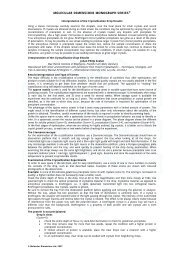(IEA Energy Papers 2011_05) Matthias Finkenrath-Cost and Performance of Carbon Dioxide Capture from Power Generation (IEA Energy Papers)-OECD Publishing (2011)
You also want an ePaper? Increase the reach of your titles
YUMPU automatically turns print PDFs into web optimized ePapers that Google loves.
© <strong>OECD</strong>/<strong>IEA</strong> <strong>2011</strong> <strong>Cost</strong> <strong>and</strong> <strong>Performance</strong> <strong>of</strong> <strong>Carbon</strong> <strong>Dioxide</strong> <strong>Capture</strong> <strong>from</strong> <strong>Power</strong> <strong>Generation</strong><br />
Introduction<br />
The Intergovernmental Panel on Climate Change (IPCC) concludes a significant reduction <strong>of</strong><br />
worldwide greenhouse‐gas (GHG) emissions is required in order to stabilise the global average<br />
temperature increase at 2.0°C to 2.4°C above pre‐industrial levels. Equivalent CO 2 emissions<br />
need to be cut by at least 50% by 2<strong>05</strong>0 compared to the year 2000 (IPCC, 2007).<br />
The <strong>IEA</strong> regularly analyses pathways for reducing energy‐related CO 2 emissions. Compared to a<br />
business‐as‐usual Baseline Scenario, carbon capture <strong>and</strong> storage (CCS) <strong>from</strong> power generation<br />
could contribute in 2<strong>05</strong>0 to 10% <strong>of</strong> the required global reduction in energy‐related CO 2<br />
emissions (<strong>IEA</strong>, 2010). Apart <strong>from</strong> CCS in power generation, CCS <strong>from</strong> industrial <strong>and</strong> upstream<br />
applications is expected to provide a similar emission reduction. CCS is thus a potential key<br />
contributor to CO 2 emission mitigation, in addition to other important aims such as improving<br />
energy efficiency <strong>and</strong> increasing renewable power generation.<br />
CCS has been applied commercially in the oil <strong>and</strong> gas industry for several decades. This includes<br />
technologies along the CCS value chain such as solvent‐based separation <strong>of</strong> CO 2 <strong>from</strong> gas<br />
streams, transportation <strong>of</strong> CO 2 by pipeline <strong>and</strong> storage <strong>of</strong> CO 2 in aquifers. CO 2 is also used for<br />
enhanced oil recovery (EOR).<br />
CCS is however still an emerging technology in the power sector, where it has not yet been<br />
demonstrated at large scale. Applying CCS to full‐size power plants requires scale‐up <strong>of</strong><br />
commercially available CO 2 capture processes. Consequently, current cost <strong>and</strong> performance<br />
information related to CCS <strong>from</strong> power generation is limited to estimates <strong>from</strong> engineering<br />
studies <strong>and</strong> pilot projects. This is different to established power technologies for which cost <strong>and</strong><br />
performance data <strong>of</strong> commercial units are well known <strong>and</strong> regularly summarised (<strong>OECD</strong>, 2010).<br />
A dedicated review <strong>of</strong> published data is needed to track latest CCS developments. The quality <strong>of</strong><br />
techno‐economic data for CCS will likely improve once additional information <strong>from</strong> the first<br />
commercial‐scale demonstration plants, which are currently in planning, become available.<br />
Meanwhile, best‐possible estimates <strong>of</strong> cost <strong>and</strong> performance <strong>of</strong> power plants with CCS are<br />
required as input for energy scenarios <strong>and</strong> as a basis for clean energy policy making. Against this<br />
background, this paper summarises <strong>and</strong> analyses techno‐economic data on CO 2 capture <strong>from</strong><br />
power generation that were published over the last five years.<br />
Page | 9




